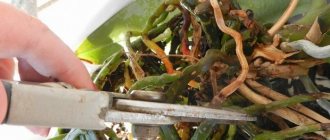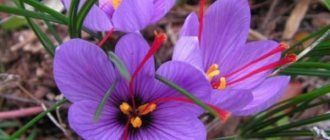Spring flowers (tulips, crocuses, muscari, daffodils) delight with bright, but not long-lasting flowering. Crocuses are one of the most popular bulbous primroses among gardeners. Their flowering lasts about a week, then the plant goes into a dormant state. What is the further care for crocus?
There is no need to annually dig up crocuses that bloom in early spring. If the flowers are healthy and bloom profusely, they can be left undisturbed for 5 years. Later, the curtain grows and needs to be divided, transplanting the corms to a new area.
Autumn crocuses (varieties that bloom in late summer) are not dug up annually. Once every five years, the overgrown clumps are divided.
Experienced gardeners advise digging up crocuses after flowering has ended if there has been poor flowering or the foliage does not look healthy. Bulbs sitting in the soil can be affected by infection or pests.
When to dig up crocuses
Different climatic conditions in our country dictate different timing for gardening. Crocuses begin to be dug up when the foliage of the plant falls to the ground and turns completely yellow. Approximate timing for removing spring crocuses from the soil:
- in the middle zone and Moscow region, excavation begins in early July;
- in the southern regions and in Ukraine - a month earlier, in June;
- in the Urals and Siberia - at the end of July.
Autumn crocuses for transplantation are dug up from late June to mid-August. The plants will bloom next year.
Do I need to dig up crocuses if they haven't bloomed?
@Taratorki
The lack of flowering in bulbous plants may indicate problems associated with a poorly chosen location or incorrect planting depth of the bulbs. Replanting the plant can correct the situation.
For crocus, choose sunny areas with well-drained, loose soil and deep groundwater. In the shade, the flower will only grow leaves, but not buds.
When planting, a full complex of mineral fertilizer for bulbous plants is applied to the soil. Low nutrient content in the soil is one of the signs of lack of flowering.
The correct depth for planting a corm in the ground is three times its height. Shallow planting leads to freezing of the bulbs in winter, and deep planting depletes the plant - all the strength of the sprout is spent breaking through the thickness of the earth in order to reach the surface; there is not enough strength for flowering.
For transplant
When a clump of crocuses grows, the plants become crowded. Leaves and flowers become smaller, flowering weakens. It's time to plant crocuses, separating the daughter bulbs from the mother bulbs.
Depending on the variety and the bulb planting pattern (loose or thickened), replanting begins every 3-5 years.
Caring for a flowering plant in a flower bed
- Watering . In spring, flowers do not need additional moisture - unless the winter was snowless, and in the spring there was almost no rain.
- Nutrition . I have already said that before planting crocuses you need to add organic matter to the soil. During the active growth of flowers, they also really need nutrition, but in this case, a complex mineral fertilizer is better suited. Just focus not on nitrogen (in rainy weather, this microelement can play a cruel joke on the flowerbed, causing fungus), but on potassium and phosphorus.
- Loosening the soil . Since the bulbs love air, the soil in the flowerbed needs to be fluffed up from time to time. At the same time, you will remove weeds that steal valuable moisture from the flowers.
By the way! From small bulbs in spring you can grow not only crocuses, but also many other elegant flowers . Which ones? See:
The process of digging crocus bulbs
Choose dry weather for work. Dig up a clump of crocuses using a pitchfork, carefully removing the cluster of bulbs along with a lump of earth.
Beacons will help you not to lose the location of the crocuses when the foliage withers. These can be plastic disposable knives stuck near the plants.
On a piece of film or tarpaulin, the earthen ball is carefully broken down and all the corms are removed. They are cleared of soil and the roots are trimmed with pruning shears.
Experienced gardeners recommend eroding the earthen ball using a stream of water from a hose. This way there is less risk of damaging the bulbs.
Crocus corms are dried in the shade and sorted. All planting material with signs of deterioration: rot, mold, sores must be destroyed. Healthy-looking bulbs are pickled in a solution of phytosporin, Maxim, or a pink solution of potassium permanganate.
Video recommendations from the Marina Flowers channel
Diseases and pests
Crocuses are quite disease resistant. And among the pests, the greatest damage is caused by rodents that eat the bulbs. Mice and moles can gnaw them, which leads to rotting and death of the plant. If the flower looks depressed, you should dig it up and carefully examine the bulb. If damage is detected, they are sprinkled with ash or crushed activated carbon and left for 2-3 hours.
If rotten areas are found, they are cut off and the same procedure is carried out. To prevent damage by rodents, the bulbs are planted in special plastic baskets, ultrasonic repellers are installed in the garden, mechanical “turntables”, etc.
The larvae of click beetles (wireworms) also like to feast on crocuses, eating holes in the bulbs. The best way to get rid of them is to make traps. At the end of spring, bunches of unrotted grass, straw or hay are laid out around the area, moistened and covered with boards. The larvae crawl into them. After 2-3 days, the traps are collected and burned along with the pests at the stake.
Storing crocuses before planting
Crocus planting material is stored in a dry and warm place until planting. The bulbs are scattered into cardboard boxes, according to the varieties, in one layer. The boxes are placed in a room with good ventilation and a temperature of +20 degrees.
Shortly before planting in the ground (a week to ten days), it is recommended to reduce the storage temperature to +15 degrees.
Elena Chursinova A practical gardener with twenty years of experience. I prefer organic farming and lazy gardening. ...
Crocuses after flowering - what to do
What to do with crocuses after their early flowering - cut off the unsightly flower stalks, but the remaining leaves are very decorative. They won't wither long enough. After the plant fades, turns yellow and the entire above-ground part of the saffron dries, the bulbs are taken out of the ground and dried. They need to be planted in early autumn so that the plants can bloom again in the spring.
Once the bulbs are dug up, they need to be stored properly. It is necessary to clean the planting material from soil and dead parts and put it in one layer for storage. The ideal conditions for the bulbs are a temperature of +22°C for successful bud formation, then in August +20°C and a week later +15°C. But at home it is stored in a dark, dry, well-ventilated room.
Additional Information! If you plant hazel grouse, daffodils, tulips and bergenia in a flowerbed together with saffron, it will retain its attractive appearance all spring - the flowers will fade, replacing each other.
However, these flowers do not require annual replanting. If saffron lives in one place for less than 3 years and soil is still visible between the plants, then care consists of mulching with a layer of peat or dry leaves.
Types and varieties of crocuses for open ground
Helpful information:
- The corm species grows in different regions: the Middle East, the European continent, the Mediterranean, Asia Minor.
- A plant from the Iris family is a perennial.
- The second name for crocuses is saffron. There are about 80 varieties and more than three hundred varieties in the world.
- The growing area in nature is open areas: meadows, steppes, fields.
- The word "saffron" means yellow. The crocus has a rich, bright shade of stamens, hence the other name for crocus.
- The bulbs are flattened, diameter is about 3 cm, there are roots, and brown scales on top.
- The height of the plant is 10 cm, there are no shoots, long, rich green leaves grow during the flowering period or immediately after it.
- The flowers are goblet-shaped, from 2 to 5 cm in diameter. The buds are not only purple with yellow stamens, but also in other shades: cream, yellow, white, purple, blue.
- Saffron from bulbs is grown not only in open ground, but also at home. With proper preparation of the bulbs, crocuses are forced for the spring holidays. Not only saffron is successfully grown by February 23 or March 8: forcing tulips and hyacinths from bulbs is popular.
- Scientists found mention of the primrose on papyri found during excavations of the pyramids of Ancient Egypt.
All varieties of bulbous flowers have their own “zest”. You can buy two or three types of crocuses of different categories so that the bright petals flutter in the wind not only in early spring, but also in autumn. Before purchasing popular, beautifully flowering perennials, it is useful to know the differences between different species so that you can choose several suitable varieties.
Interesting options for botanical saffron:
- Oxonian.
- Albus.
- Valikola.
- Banatavsky.
- Cassiole.
- Pallas saffron.
Spring-flowering
Popular varieties:
- Saffron Heufelliana (blooms even in the snow).
- Crocus Thomas.
- Violet Queen.
- Alatavsky.
- Joan of Arc.
- Kathleen Perlow.
- Spring.
- Blue Pearl.
- Snowstore.
- Pickwick.
- Blue Bonnet.
- Saffron Korolkova.
- Cream Beauty.
- Gubel Edelitern.
Large-flowered
The second name is Dutch crocuses. An original hybrid with highly decorative specimens was created by crossing yellow and spring types of saffron. A characteristic feature is a variety of colors, large buds, and a relatively long flowering period. The popular variety Jeanne Darc has large white buds and contrasting stamens.
Two-colored
One of the interesting varieties of Dutch hybrids. These include the popular Pickwick variety: the white veins look impressive against the soft lilac background of the petals.
Crocus sativa is a popular spice. In the Middle Ages, saffron was so valuable that it got its name not only because of its yellow stamens, but also because of its high price, which was comparable to the cost of gold. It is no coincidence that the primrose is called the “Golden Flower”. The stigmas of saffron sativum give dishes a pleasant, rich, “not boring” yellow color.
Why replant crocuses?
Hyacinths have faded: what to do with them next
Although saffron is not dug up every year, after 3 or 4 years the need for this procedure becomes necessary. When to transplant crocuses to a new place - the best time for this is in July, when the flower has a dormant period. Over such a long period, the mother bulb manages to acquire many daughter bulbs, they interfere with each other, and the flowers become smaller. To help the flower recover, transplantation is carried out.
Crocus transplant
Pest damage during storage
During this period, check for blooms, damage and diseases monthly. Spoiled planting material is immediately rejected.
Rodents pose a great danger: mice, rats. Their entry into the room with onions is unacceptable. Complete isolation from rodents can be achieved by placing the tubers in glass or iron containers and covering them with lids with holes for ventilation.
Caring for the quality and safety of planting material is the key to magnificent crocus flowering. It won’t take much time, but it will give several months of aesthetic pleasure to the whole family.
Crocuses (saffron) are very popular among gardeners. But if almost no questions arise about caring for the plant, then after flowering many do not know what to do with their bulbs.
There is no consensus on whether crocuses should be dug up after flowering. Some gardeners see the need to hold this event annually. Others believe that this can only be done once every 3-5 years. Both statements are true in their own way.
But you can find out for sure about the need for this event only by familiarizing yourself in more detail with the conditions for their cultivation.
Do I need to dig it up?
No matter how much gardeners argue about the need to dig up saffron, a decision must be made based on several factors:
- climate;
- variety;
- preliminary forcing.
If the climate allows crocuses to be left overwintering in open ground, then it is not necessary to remove them from the soil. When this is not possible, immediately after flowering the planting material is removed from the soil. Otherwise, the plant may develop fungal or bacterial diseases (fusarium, gray rot, etc.).
In harsh climates, bulbs need to be dug up every year. The only exceptions are plants after home forcing. In order not to destroy the bulbs, the planting site is insulated with straw, dry leaves or mulching material.
When to dig up crocuses after flowering in conditions of sharp temperature changes? When the above-ground part completely withers, the bulbs are removed from the ground. It is better to do this during the plant's dormant period - from mid-June to the end of summer. Healthy specimens are selected from the resulting planting material and placed in a ventilated room where the temperature is maintained at +18-+20 degrees. They are not taken out from there until the very moment of landing.
When to replant crocuses after flowering
It is not worth replanting crocuses every year to a new place. It is enough to carry out this event once every 3-4 years. Crocuses with early flowering are replanted during the dormant period, from July to September. Late flowering - from June to August. By this time, the bulbs have time to acquire “babies”. If they are not separated during transplantation, the plant’s flowering will be smaller and less frequent.
In order for crocuses to bloom, you need to store the bulbs correctly.
Caring for faded plants
Caring for crocuses after flowering is easy. It is the same for flowers grown at home and stored in open ground. When the flower has faded, its peduncles are cut off without affecting the leaves. Only when the entire above-ground part turns yellow and dries out are the bulbs dug out of the soil.
How to store crocus bulbs
In order for crocuses to bloom profusely in the spring, you need to ensure they are properly stored. After digging, the planting material is cleared of soil, dead scales are removed from it, rotten areas are removed and laid out on a flat surface in one layer. The temperature at the storage location should first be +22, at the end of summer, +20, and then - +15. Cooling the planting material is an imitation of natural wintering conditions, allowing the saffron to gain vitality for future growth and flowering. The room where the bulbs are located should be well ventilated, dark and dry.
How to store at home
The air in the room where the planting material is located should be fresh and cool. The temperature should be +15..+18 °C during the entire storage period.
Storing bulbs in boxes
For spring crocuses, the period of rest and storage is July-September, and for autumn crocuses - June-July.
Indoor crocuses and those for forcing are stored until early spring. At the same time, a lower temperature regime is observed - +10..+13 ° C. They are planted 2.5 months before the desired flowering period.
Important storage rules before replanting crocuses:
- air temperature is not higher than + 18 °C and not lower than 0 °C;
- dry, well-ventilated area;
- cannot be placed in plastic bags, poured in bulk or folded in several layers in one container.
Attention! In cold weather, the onions are stored on an insulated balcony at an air temperature no higher than + 18 °C and no lower than 0 °C.
Cardboard and plastic wooden boxes with holes for ventilation, wide low containers with a layer of sandy soil and drainage and holes in the bottom, a nylon stocking or mesh bag, and paper trays for eggs are suitable.
Crocuses for forcing are placed on the shelves of a dry basement or cellar, where the temperature does not rise above + 10..+15 °C. Use the same container as for storage on the balcony. If the basement is visited by rodents, then the planting material is placed in one layer in small glass or metal jars and covered with a lid with narrow holes.
In the summer months, if there is no basement, each onion is wrapped in newspaper or thick paper and placed on the lower shelves or in refrigerator drawers. Containers and pots with crocuses are also placed there until the time for planting comes.
What bulbs to plant
The first thing to do is choose good planting material. Unlike other bulbous plants, the size of crocuses is measured not by diameter, but by circumference at its widest point. We need packaging with the number 10 plus on it. From such raw materials the largest flowers on thick stems are obtained. And up to 6 pieces at the same time.
If there is a smaller number on the package, then there will be fewer colors accordingly. They themselves will be small.
Choose for yourself varieties bred in Holland. These are mostly hybrids. They work very well at home. Native or natural plants produce small flowers or do not bloom at all. Why then all the work? And do not confuse them with plants that bloom in autumn. During your forcing, they just have a period of deep rest after flowering.
But it’s not enough to be seduced by a beautiful photograph on cardboard. You need to have some more understanding about the correct choice of corms. They must meet the following requirements:
- Firm and elastic. Lightly press the raw material. It should spring pleasantly. Softness indicates beginning damage.
- Smell it if possible. If there is even the slightest odor of mold, put it off without regret. Such material was stored in inappropriate conditions.
- Carefully inspect the bulbs. They should not have dark or damp spots or visible damage.
Once you have made your choice and brought your purchase home, take your time. Quarantine the bulbs. Dark, cool place. Look at them in about 10-12 days. Everything is fine? Are there any signs of disease, mold or rot? This means you can plant safely.
Advice. Buy corms when they are in season. This time is from the end of July to the end of September.











